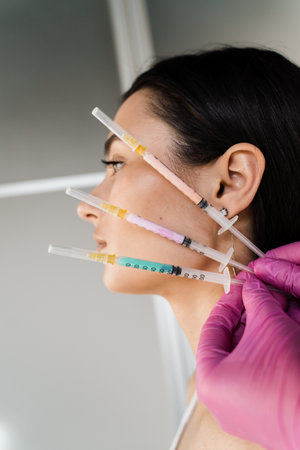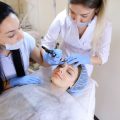Introduction to Lip Fillers in the UK
Lip fillers have become a mainstay in British aesthetic practice, reflecting shifting beauty ideals and increasing acceptance of non-surgical cosmetic enhancements. At their core, lip fillers are injectable treatments—most commonly containing hyaluronic acid—that add volume, shape, and definition to the lips. Over the past decade, these procedures have moved from being a celebrity-driven trend to a widely accessible option available on high streets across the UK. This surge in popularity is closely linked with the influence of social media, reality television, and public figures who openly discuss their cosmetic journeys. Despite this growing mainstream appeal, attitudes towards aesthetic procedures in Britain remain nuanced. While younger generations tend to embrace these enhancements as routine self-care or confidence-boosting choices, older demographics may still view them with some scepticism or reserve. British cultural values often favour subtlety and natural-looking results over dramatic transformations, leading practitioners to prioritise techniques that enhance rather than drastically alter appearance. As such, lip fillers in the UK are not just about achieving fuller lips—they embody a broader conversation about self-expression, personal agency, and evolving standards of beauty.
2. Types of Lip Fillers and Their Composition
When considering lip augmentation within the UK, it’s essential to understand the range of filler substances available and their respective compositions. British aesthetic clinics overwhelmingly favour products that are clinically approved, safe, and deliver natural-looking results. The most popular fillers are hyaluronic acid-based, but there are alternative materials worth noting for their distinct characteristics and suitability.
Hyaluronic Acid (HA) Fillers
Hyaluronic acid (HA) is by far the most widely used substance in British lip enhancement procedures. HA is a naturally occurring molecule found in the skin, renowned for its hydrating properties and ability to add subtle volume. Its appeal lies in its reversibility—should any issues arise, an enzyme called hyaluronidase can dissolve the product rapidly. Moreover, HA fillers offer predictable results and are generally well tolerated by most clients.
Popular Brands Used in the UK
| Brand Name | Key Features | Longevity | Notes |
|---|---|---|---|
| Juvederm® | Smooth consistency, versatile range for subtle or dramatic effects | 6-12 months | Widely available; commonly used for first-time patients |
| Restylane® | Slightly firmer gel for defined shaping and contouring | 6-9 months | Favoured for precision work on lip borders |
| Teosyal® Kiss | Designed specifically for lips; soft yet durable texture | 6-9 months | Low swelling post-procedure; increasingly popular in UK clinics |
| Belotero® Balance | Smooth integration with natural tissue; minimal lumpiness risk | 6-9 months | Preferred for subtle enhancement and fine lines around lips |
Alternative Filler Substances (Less Common)
While hyaluronic acid fillers dominate the market, a few alternative substances have been approved for use in the UK. However, these are now less frequently selected due to safety profiles and patient preference.
Collagen-Based Fillers:
Mainly replaced by HA due to higher allergy risks and shorter duration. Rarely used in modern British practice.
Calcium Hydroxylapatite:
This substance is thicker than HA, providing longer-lasting results but is more suited to deeper facial wrinkles than lips.
Poly-L-lactic Acid:
A biostimulatory filler that promotes collagen growth over time, but not typically chosen for delicate lip tissue due to potential firmness.
Cultural Preferences in British Aesthetic Practice
The prevailing trend within British aesthetics leans towards subtlety and enhancement rather than dramatic transformation. This is reflected in the preferred choice of softer HA fillers and skilled injection techniques aimed at preserving natural movement and avoiding the “overfilled” look sometimes seen elsewhere. Patients often seek understated refinement that harmonises with their facial features—a hallmark of British cosmetic sensibility.
The selection of filler type, brand, and formulation should always be tailored to individual anatomy and desired outcomes, best determined through consultation with a qualified practitioner experienced in British standards of care.
![]()
3. Common Techniques Used by British Practitioners
Within the UK, aesthetic practitioners are renowned for their commitment to subtlety and natural-looking enhancements. The predominant approach is to enhance, rather than transform, a client’s features, aligning with British preferences for understated beauty. Among the most popular techniques is the linear threading method, where filler is carefully injected along the natural contours of the lips to create even volume and definition. Another favoured technique is the micro-droplet or microbolus method, which involves tiny injections distributed across different areas of the lips. This allows for precise shaping and minimises the risk of overfilling—a concern frequently raised in British aesthetic circles.
The Russian Lip Technique
An increasingly popular trend in UK clinics is the Russian lip technique, which aims to achieve a heart-shaped, lifted appearance without excessive volume. By injecting vertically into the border of the lips and then sculpting upwards, practitioners can create a more pronounced Cupid’s bow while maintaining a refined silhouette. This style is often requested by clients seeking a modern yet elegant enhancement that steers clear of the so-called ‘duck lip’ effect.
Bespoke Blending and Tailored Assessment
Personalisation remains at the forefront of British practice. Many professionals utilise a combination of methods—such as blending linear threading with micro-droplets—to best suit individual anatomy and desired outcomes. Prior to any procedure, thorough consultations are standard; these involve assessing facial proportions and discussing realistic results. This careful planning is highly valued within UK aesthetics and helps ensure treatments result in lips that complement each client’s unique features.
Emphasis on Safety and Subtlety
Above all, safety underpins every technique used by reputable British injectors. Use of hyaluronic acid-based fillers—favoured for their reversibility and compatibility with human tissue—is standard practice. Layering product gradually, rather than injecting large volumes at once, further reduces risks and supports gradual refinement. Such practices reflect the British ethos: prioritising natural beauty, patient wellbeing, and results that blend seamlessly into daily life.
4. Current Trends in British Lip Enhancement
The landscape of lip fillers in the UK has evolved remarkably over recent years, with both subtlety and personalisation taking centre stage. This shift can be attributed to a blend of celebrity influences, social media trends, and a growing emphasis on natural aesthetics. Below, we delve into the most popular styles, how beauty standards are changing, and the way British preferences differ from global trends.
Popular Styles in British Aesthetic Practice
| Style | Description | Key Features |
|---|---|---|
| Natural Enhancement | A subtle increase in volume that maintains the lips’ original shape. | Soft contours, minimal projection, balanced proportions. |
| Defined Cupid’s Bow | Focuses on accentuating the cupid’s bow for a youthful look. | Sharp definition, slight lift at the centre of the upper lip. |
| Russian Technique | Lifts the centre of the lips for a heart-shaped appearance without excessive volume. | Vertical injection technique, flat profile from the side view. |
| Pillow Lips | Evenly distributed filler for plumpness across both lips. | Fullness throughout, soft edges, smooth texture. |
Celebrity Influence and Social Media Impact
British celebrities such as Rosie Huntington-Whiteley and Dua Lipa have championed understated yet glamorous lip enhancements, encouraging a move away from exaggerated looks. The popularity of reality TV personalities has also played a role, though there is a noticeable difference between trends seen on television and those requested by everyday clients. Instagram and TikTok have become pivotal platforms where practitioners share before-and-after results, further steering public perception towards refined outcomes rather than dramatic transformations.
Evolving Beauty Standards Across the UK
The prevailing attitude in Britain leans toward sophistication and authenticity. Many clients seek to enhance their features without appearing “done.” This is mirrored in regional differences—London clinics often report higher demand for trend-driven styles like the Russian Technique, while practices in the North favour classic enhancements tailored to individual facial anatomy. There is also an increasing awareness of diversity in lip shapes and sizes, prompting practitioners to adopt more bespoke approaches.
Summary of Shifting Trends
| Influence Factor | Impact on Lip Filler Trends |
|---|---|
| Celebrity Culture | Subtle glamour over overt augmentation; rise of “model-off-duty” looks. |
| Social Media | Increased transparency; demand for realistic expectations and natural results. |
| Diversity & Inclusion | Bespoke treatments respecting unique facial features and ethnic backgrounds. |
| Regulatory Awareness | Preference for qualified practitioners and safe products over cheap alternatives. |
Conclusion: The Future of British Lip Enhancement
Lip filler trends across the UK reflect a nuanced approach that values individuality and long-term satisfaction. As beauty ideals continue to shift towards authenticity and safety, British aesthetic practices are likely to see sustained growth in personalised techniques that celebrate each client’s distinct features while delivering naturally enhanced results.
5. Safety, Regulation, and Aftercare in the UK
Understanding National Regulations
Lip fillers are classified as non-surgical cosmetic procedures in the UK. The industry has undergone significant scrutiny, leading to tightening of regulations to protect public safety. While dermal fillers are not currently prescription-only medicines, reputable clinics and practitioners adhere to guidelines set out by bodies such as the General Medical Council (GMC), Care Quality Commission (CQC), and saveface.co.uk—a government-recognised register of accredited aesthetic practitioners. Recent legislative discussions suggest further regulation is likely, aiming to ensure only qualified professionals provide treatment.
Practitioner Qualifications and Choosing a Provider
One of the most critical factors for patient safety is selecting a qualified practitioner. In the UK, medical professionals such as doctors, dentists, nurses, or pharmacists with additional training in aesthetics are typically considered best suited for administering lip fillers. It is advisable to check for membership in recognised professional associations like the British Association of Cosmetic Nurses (BACN) or the Joint Council for Cosmetic Practitioners (JCCP). Patients should always verify qualifications, insurance status, and clinical experience before booking a procedure.
Potential Risks and How to Mitigate Them
Although lip fillers are generally safe when performed by experienced practitioners, risks remain. Common side effects include swelling, bruising, tenderness, and temporary asymmetry. More serious complications—such as vascular occlusion or infection—are rare but require immediate medical attention. To minimise risks, it is essential to provide a full medical history during consultation and follow all pre- and post-procedure instructions closely.
Recommended Aftercare Practices
- Avoid touching or massaging the lips unnecessarily for at least 24 hours post-treatment.
- Apply cold compresses gently to reduce swelling.
- Refrain from strenuous exercise, alcohol consumption, and extreme temperatures (saunas or sunbeds) for at least 24-48 hours.
- Stay hydrated and keep lips moisturised using recommended products.
- Report any unusual pain, persistent swelling, or signs of infection to your practitioner immediately.
Summary
The UK takes safety in cosmetic procedures seriously. By adhering to national regulations, choosing qualified professionals, understanding potential risks, and following aftercare advice diligently, patients can significantly enhance their overall experience and outcomes with lip fillers.
6. Patient Experience and Cultural Considerations
Advice on Choosing a Practitioner
In the UK, the demand for lip fillers has led to a proliferation of practitioners offering this service, but it is essential to choose wisely. Look for clinicians registered with reputable bodies such as the General Medical Council (GMC), the Nursing and Midwifery Council (NMC), or the British Association of Aesthetic Plastic Surgeons (BAAPS). Ensure your chosen professional has a proven track record in aesthetic procedures, particularly with injectable treatments. Do not hesitate to request before-and-after photos of previous clients and read independent reviews. In Britain, transparency and professionalism are highly valued, so a trustworthy practitioner will happily answer your questions about qualifications, technique, product choice, and aftercare.
What to Expect During Consultation and Procedure
The consultation is a critical step in the British approach to lip enhancement. You should expect a thorough discussion covering your medical history, desired outcomes, and realistic expectations. Practitioners in the UK often take a conservative stance, prioritising natural-looking results that harmonise with individual facial features. During the procedure itself, a topical numbing agent is typically applied for comfort. The filler is then carefully injected using precise techniques tailored to achieve symmetry and proportion. The entire process usually takes less than an hour, with minimal downtime—though some swelling or bruising is common for a few days post-treatment.
Unique British Perspectives on Lip Enhancements
British aesthetics place great emphasis on subtlety and refinement rather than dramatic transformations. Many clients seek enhancements that complement their features without appearing overtly ‘done’. There remains a degree of cultural reservation around cosmetic procedures; discretion is often appreciated both by patients and practitioners. Additionally, popular trends in the UK tend towards understated volume and well-defined contours rather than exaggerated fullness seen elsewhere. Open communication with your practitioner about your desired look—and being receptive to their professional judgement—will help ensure results that align with prevailing British tastes.
Final Thoughts
Navigating lip filler options within the UK requires careful consideration of both practitioner credentials and cultural attitudes towards aesthetics. By prioritising safety, open dialogue, and natural-looking results, you can enjoy an experience that upholds the highest standards of British aesthetic practice.


